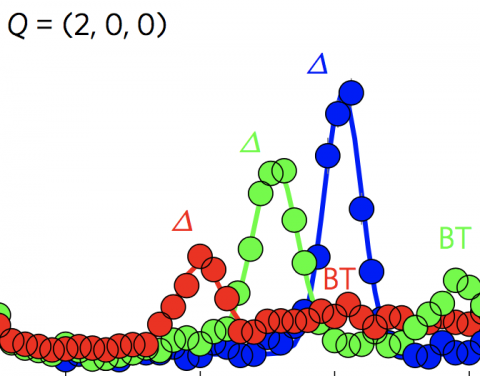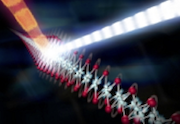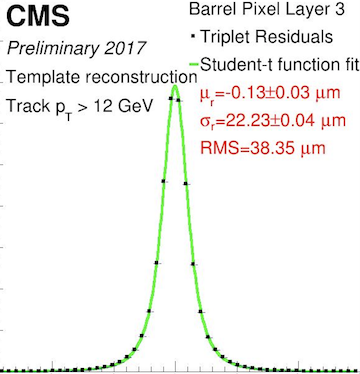|
|
Dear colleagues
The European neutron landscape is changing rapidly. Two reactor-based sources will close in the next few years, while the European Spallation Source (ESS) will come online in 2019. At PSI, we have started an upgrade program of the neutron guide system of SINQ and some of the instruments. The goal is to optimize neutron instrumentation for smaller samples and complex sample environments - two aspects that hold great potential to solve some of the grand challenges facing our societies.
|

Michel Kenzelmann
|
|
We are in an excellent position for our upgrade plans because of our decade-long investments in neutron optics, novel instrument designs and reliable cryogenic equipment. In the future, we will be able to provide small, high-flux neutron beams tailored to small samples under extreme conditions. This should be of high interest to materials scientists.
Possibly even more important is that we stepped up our efforts to educate young materials scientists in their use of neutrons. This is crucial because many fundamental questions can only be solved using a range of complementary techniques, and barriers to access neutron facilities have to be lowered through better training and computational support.
Michel Kenzelmann,
on behalf of the Laboratory for Neutron Scattering and Imaging, LNS
|
|
Next proposal submission deadlines:
|
|
|
Three-dimensional magnetization structures revealed with X-ray vector nanotomography
 SLS - First-time 3D imaging of internal magnetic patterns SLS - First-time 3D imaging of internal magnetic patterns
For the first time, scientists have made visible the directions of the magnetisation inside a 3D magnetic object. The smallest details in their visualisation were ten thousand times smaller than a millimetre. Among others, the magnetic structure contained one outstanding kind of pattern: magnetic singularities called Bloch points, which up to now were only known in theory.
Read the full story
|
|
|
C. Donnelly et al, Nature 547, 328 (2017)
|
|
|
4-spin plaquette singlet state in the Shastry-Sutherland compound SrCu2(BO3)2
SINQ - On the way to understand quantum magnetism
The study of interacting spin systems is of fundamental importance for modern condensed-matter physics. On frustrated lattices, magnetic exchange interactions cannot be simultaneously satisfied, and often give rise to competing exotic ground states. The frustrated two-dimensional Shastry–Sutherland lattice realized by SrCu2(BO3)2 is an important test to our understanding of quantum magnetism. It was constructed to have an exactly solvable 2-spin dimer singlet ground state within a certain range of exchange parameters and frustration. While the exact dimer state and the antiferromagnetic order at both ends of the phase diagram are well known ...
Read the full story
|
|
|
M.E. Zayed et al, Nature Physics, adv. online publication (July 2017)
|
|
|
Complementary response of static spin-stripe order and superconductivity to nonmagnetic impurities in cuprates
 SμS and SINQ - Magnetic stripe order and superconductivity SμS and SINQ - Magnetic stripe order and superconductivity
We report muon-spin rotation and neutron-scattering experiments on nonmagnetic Zn impurity effects on the static spin-stripe order and superconductivity of the La214 cuprates. Remarkably, it was found that, for samples with hole doping x ≈ 1/8, the spin-stripe ordering temperature Tso decreases linearly with Zn doping y and disappears at y ≈ 4%, demonstrating a high sensitivity of static spin-stripe order to impurities within a CuO2 plane. Moreover, Tso is suppressed by Zn in the same manner as the superconducting transition temperature Tc for samples near optimal hole doping. This surprisingly similar sensitivity suggests that the spin-stripe order is dependent on intertwining with superconducting correlations.
Read the full story
|
|
|
Z. Guguchia et al, Physical Review Letters 119, 087002 (2017)
|
|
|
Femtosecond electron-phonon lock-in via photoemission and x-ray free-electron laser
 SwissFEL - first direct look at how electrons ‘dance’ with vibrating atoms SwissFEL - first direct look at how electrons ‘dance’ with vibrating atoms
Scientists at the SLAC National Accelerator Laboratory and Stanford University - one of the leading authors, Simon Gerber, has in the meantime relocated to PSI - have made the first direct measurements, and by far the most precise ones, of how electrons move in sync with atomic vibrations rippling through an quantum material, in the present study an unconventional superconductor, as if they were “dancing" to the same beat. The atomic vibrations are called phonons and the measured electron-phonon coupling, for certain electron “orbitals", was 10 times stronger than standard theory had predicted – making it strong enough to potentially play a role in unconventional superconductivity ...
Read the full story.
|
|
|
S. Gerber et al, Science 357, 71 (2017)
|
|
|
Commissioning and first performance studies of the new CMS pixel detector
 Particle Physics - Pixel detector commissioned by PSI Particle Physics - Pixel detector commissioned by PSI
In the previous months the new CMS pixel detector was brought into operation. The detector was moved from PSI to CERN and installed in February, followed by an intensive period of commissioning and calibration. This process mostly involved the adjustment of many operational parameters which influence the detector performance, e.g. the individual pixel thresholds had to be optimized for each pixel in order to achieve the best possible detector resolution – a challenging task, as there are 80 million pixels which operate at a readout speed of 40 MHz and have to cope with rates of up to 500 MHz/cm2 in the inner part of the detector. The detector consists of 4 cylindrical barrel layers ...
Read the full story
|
|
X06DA-PXIII - a phasing beamline at SLS
SLS
The beamline X06DA-PXIII was originally designed for maximum efficiency to enable high-throughput crystallographic measurements for users from both academia and industry. Its remarkable simple and stable design turned out to be highly suitable for de novo structure determination experiments, which require highly accurate data. X06DA offers a unique set of hardware and software tools for phasing data collection strategies. The current increase in number of structures solved de novo from native macromolecular crystals reflects the routine use of a simple and fast phasing data collection protocol developed at X06DA, which has proven effective on highly challenging cases. More information.
|
|
ZEBRA: the new neutron single crystal diffractometer
SINQ
In 2017 we commissioned and performed user experiments on the new single crystal neutron diffractometer ZEBRA, which replaced the TRICS instrument. The new diffractometer is designed for measurements on small, milimeter-sized crystals and requiring extreme sample environments. In 2018 the analyzer unit will be completed, further increasing the peak to background ratio. ZEBRA is optimised for parametric studies. More information.
|
|
New type of pressure cell
SμS
A new double-wall piston-cylinder type pressure cell made out of an inner CuBe and an outer MP35N cylinder has been developed recently and is ready for user operation. Muons stopping in the inner CuBe cylinder produce an unavoidable background which for this material however is temperature independent leading to a much improved data quality. The design was guided by finite-element analysis (FEA) using the stress-strain characteristics of the materials. The new cell allows a safe and repeatable usage for pressures up to 2.2 GPa at low temperatures.
|
|
First beam in optics hutch
SwissFEL
On August 31st, 2017, SwissFEL reached the next milestone by sending the first X-rays into the optics hutch. The Aramis undulators of SwissFEL produced SASE-radiation with 1.2 nm wavelength. The beam entered the Aramis-beamline along the pink beam path of Bernina via two vertical offset mirrors and was detected on the diagnostic photon screen at the end of the optics hutch. We are now looking forward to the next commissioning time in October to commission the monochromatic beam path of Bernina and the second branchline Alvra.
|
|
A large germanium detector array for muonic atom spectroscopy
Particle Physics
Muonic atoms as laboratories for fundamental physics provide crucial input to quantum electrodynamics, the weak and the strong interaction. Many studies of muonic atoms have relied on the detection of X-rays from the muonic cascade. For the first time in the history of muonic atom spectroscopy we have employed a large germanium detector array consisting of 13 detectors provided by PSI, KU Leuven and the French/UK Ge Pool for the detection of the X-rays emitted in the muonic cascade. With the help of this array we were able to push down the limit on the available target mass needed to form the muonic atoms to 5 μg, which opens the path to the study of radioactive atoms that cannot be handled in higher quantities such as 226Ra. Additionally the array was used to perform higher multiplicity studies of the cascade and search for the elusive single photon 2s-1s transition that has never been observed.
|
|
JUSAP - The Joint Users Association
Dear colleagues
In the last issue, we were informing you about the start on May 1st, 2017 for 4 years of the HORIZON2020 CALIPSOplus project, being coordinated by Helmholtz-Zentrum Dresden-Rossendorf. More information can now be found here.
|

Claude Monney
|
|
Moreover, the local user community of the SESAME synchrotron (Synchrotron light for Experimental Science and Applications in the Middle East) located in Jordan is searching for scientific partnerships with scientists being experienced as synchrotron users and willing to build a joint scientific project with them. This would mean e.g. support in drafting the proposal for beamtime request or support in conducting the first experiment. Scientific teams from the Middle East region and corresponding possible questions to be tackled in different scientific areas have already been identified. For more details, interested users are welcome to contact our Swiss ESUO delegate, Annick Froideval.
SμS users are reminded that there will be reduced availability of beamtime in both 2018 and 2019. For those experimentalists needing a CW source, it is important to submit proposals in time for the December 31st deadline at PSI or the December 2017 deadline at TRIUMF.
We encourage you, members of the PSI user community, to communicate to us any issues, concerns or suggestions. In this case, please contact me directly or other committee members. Your input will be discussed during the next meeting of the JUSAP committee, which will take place in October 2017.
Yours sincerely,
Claude Monney (on behalf of the JUSAP committee)
|
|
Upcoming events
Please have a look at our conference calendar.
|
|
|
|